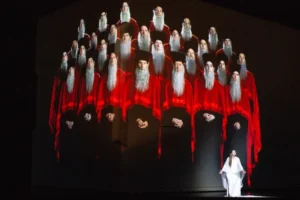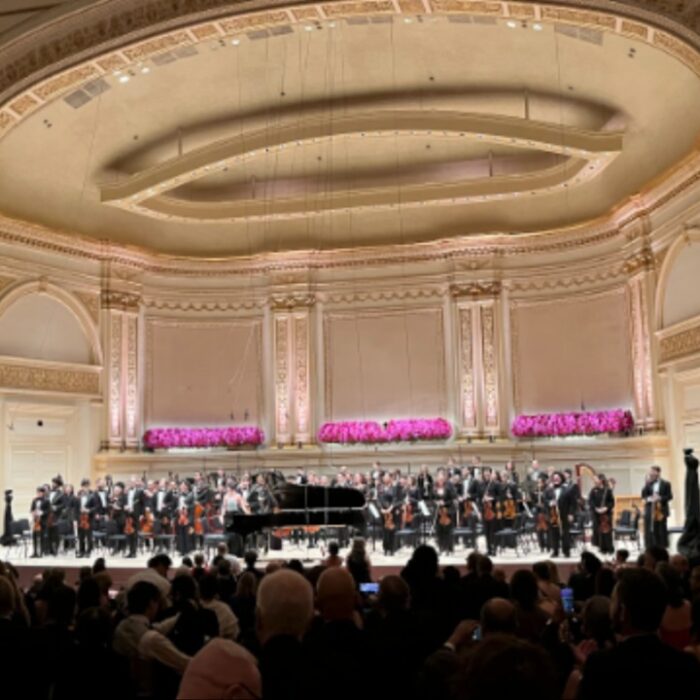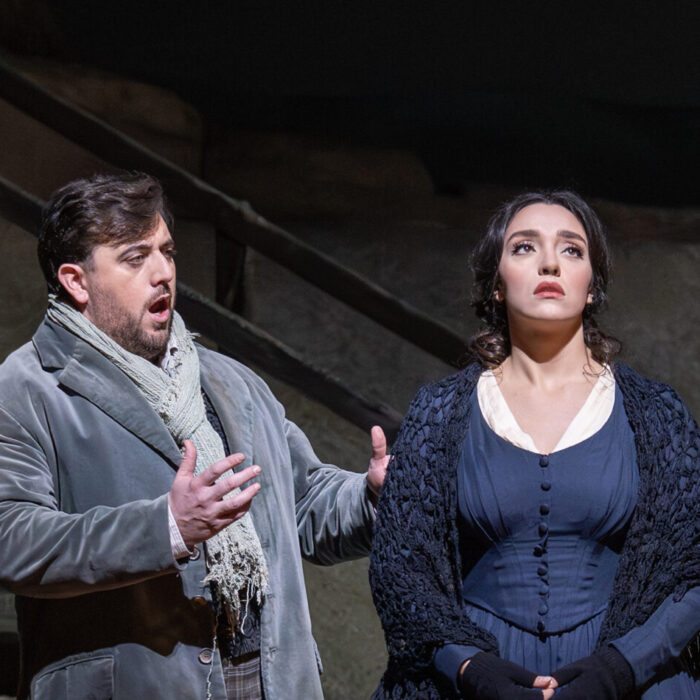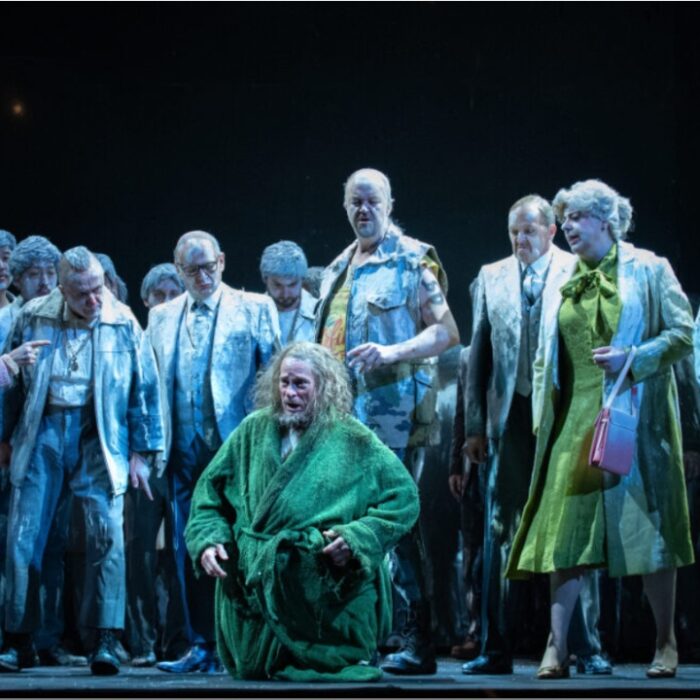
Opéra National de Paris 2025-26 Review: Aida
A Powerful & Timely Staging of a Cornerstone Masterpiece
By Matt Costello(Credit: Bernd Uhlig)
“Aida,” as we know, was supposed to be Giuseppe Verdi’s last opera. At least, he thought so.
Along with his powerful “Requiem,” and all its operatic overtones, his very final work to come, the moving and gentle “Quattro Pezzi Sacri” – “Aida” was supposedly the prolific master’s operatic swan song.
But, well, that is certainly not what occurred. Though the miracle of “Otello” was in the distant future from Aida’s supposed ‘farewell.’
Verdi had accepted his “one last commission” from the Khedive of Egypt, Isma’il Pasha, to create this perhaps most ‘grand’ of grand opera. Based on a scenario suggested to Khedive by the Egyptologist Auguste Mariette, “Aida” quickly became a piece that conquered the operatic world in a way that–I would suggest–even his most wildly successful pieces perhaps did not.
From its premiere in Cairo, to–rather quickly–the great European opera houses, and on to the new world where, premiering in German, it became a dominant piece at New York’s Metropolitan Opera.
And for this masterpiece, Verdi had a very strong libretto, with a clear and powerful story of two nations at war–and with two lovers caught in between. Antonio Ghislanzoni’s libretto for the work also featured a competitor for the Egyptian general Radames’s affection, the riveting role of Amneris, daughter of the king; a tremendous and multi-faceted character that greatly amplifies the already substantial drama.
While I regularly cover opera and choral works at the various festivals in Northeastern U.S., such as Tanglewood and Gilmmerglass, this work–by way of an original production at the Salzburg Festival–was my first time reviewing so far from my New York home. That it was at the striking Opéra Bastille made the evening all the more exciting.
Production Details
Director and video artist Shirin Neshat, who also directed the powerful black and white videos that play a major role in the staging, made the production clearly focused on presenting this classic opera in a way that no one would have experienced before.
The staging tackled–in a realistic, dramatic and significantly moving way–the interactions of two countries at war and how the victor can treat the defeated. With all the sheer brutality and loss of life with such a defeat, it plays out in the real world.
It is certainly doubtful that anyone has heard–as we do in this production–machine gun fire during this opera as the captured Ethiopians are shot before our eyes. And this, after having been brutally stripped of their clothes.
Perhaps this question comes to mind: was the staging, with its gut-wrenching moments, jarring in any way with the musical performances–which were magnificent?
In response, I bring my own personal perspective into this, and I date it to a landmark premiere I attended.
The date was 1976. The occasion: the premiere of the centennial production of Wagner’s “Der Ring des Nibelungen” at Bayreuth, directed by the brilliant Patrice Chereau and conducted by Pierre Boulez. (The latter of course not yet known for his affinity for the late romantic repertoire, adding to the revolutionary nature of this historic production.)
With its envisaging of the massive impact of the industrial world, with the Rhinemaidens–seen as strumpets strolling about a hydro electric generator, obsessed with their gold–this was to be a “Ring” unlike any other.
For me, it was musical theater distilled to its very essence. Shocking at points. Unexpectedly moving at others. And always– and this is key–deeply thought-provoking and musically riveting.
The production made one examine not only Wagner and his work, but the period of its origin and our current world.
Attending such a historic premiere, I remember the loyal Bayreuth patrons, many of them, passionately booing the production and its director. I do admit, being young and perhaps a tad radical in those days, to cheering loudly in response.
Which brings us to this: Shirin Neshat’s remarkable “Aida.”
I was enthralled by this production. While I would not necessarily suggest this to someone as their first experience of the classic “Aida,” it certainly encompassed all the artistic and theatrical boxes mentioned above. It drilled deep into what is absolutely core to the story–the vision of the victorious and brutal soldiers interacting with their shattered prisoners.
That vision here was brought to powerful life by the video scenes of their capture and humiliation. This experience elicited many important thoughts and observations. But did it somehow disrupt or distract from the central tale of a fatal love triangle on the banks of the Nile?
Not for me. It did, I admit, have me examining just who this Radames was, as well as Amneris, even Aida. Here they are all seen with greater depth and resonance, through the backdrop of this ground-breaking staging.
Easily, this was one of the most riveting and fulfilling nights at the opera I have ever had. Controversial? Undoubtedly.
But just as the 100-year Chereau Ring cycle, which finished its run years later to a 45-minute standing ovation, shows how art–and people’s response to it–can and will change. Time does work wonders. So does understanding and relevance, which this “Aida’ also clearly delivers.
Musical Highlights
So then, onto “Aida’s” amazing music. The core singing trio of the opera was magnificent. Tenor Piotr Beczala was everything the besotted warrior Radames should be, with a heroic voice that reminded me of Jussi Björling, lyrical yet with all the power needed for the demands of this role.
From the moment Beczala came to the stage, launching into his aria “Celeste Aida,” his acting, as both someone with a forbidden love and the commander of militaristic Egyptian forces, the international star was perfect, strong and conflicted. He made us believe in his love for Aida.
He was matched with the great Ewa Plonka as Aida, internationally experienced with many demanding roles, including Tosca, Turandot, as well as Aida. Plonka’s soprano voice thrillingly soared over the massive chorus and orchestra in the grand ensembles, while maintaining a clear and warm tone, despite the sheer force needed.
Beczala and Plonka made a wonderful pair, equally matched with an Amneris, daughter of the king, doing all she can to destroy the relationship. The portrayal by Eve-Maud Hubeaux beautifully humanized the character, even as she sealed her spurned lover’s fate to be buried alive for treason.
And in those scenes, where the opera becomes so powerfully Amneris’s, she was all one could wish for in such a complex character, certainly one of Verdi’s finest vocal creations.
More Illuminating Cast Details
The rest of the cast matched those dizzyingly high standards, such as the beautifully rich singing of Alexander Kopeczi as Ramfis, the powerful high priest.
Roman Burdenko as the Ethiopian king, Amonasro, not only displayed a vocal fierceness and realism, but showed moving acting ability to match the brutality this production details for the captives.
Likewise, Krzysztof Bączyk as the King commanded the stage and his brutal kingdom with profound vocal power, while also conveying his very human dilemma, namely his strong-willed daughter and her wishes to possess the king’s triumphant general.
And the chorus, under the direction of Ching-Lien Wu, delivered the full emotional power of those massed ensembles that provide so much of the sheer excitement of this grandest opera.
Michele Mariotti’s conducting of the orchestra revealed nuance and intriguing elements in the well-known score that I had not noted before. Her careful and expressive conducting made the over 150-year-old opera sound as fresh and vital as the staging mounted by the brilliant director, Neshat.
And for me, remembering the groundbreaking and, at the time, controversial “Ring” so long ago, we need to welcome interpretations like this because the rewards of doing so provides fresh insights. By challenging ideas, and yes, strong images to grapple with, this only enriches the musical, dramatic and human experience.
It’s what art and what opera at its best and most artistic is.
And for those who get to see this production, and experience it–perchance in Paris?–will be very lucky indeed.


